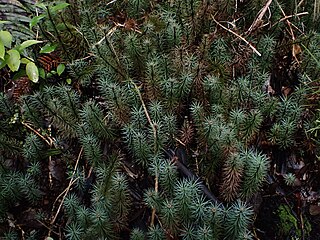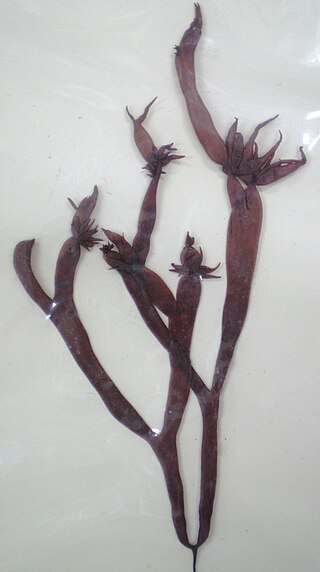
Ötzi, also called the Iceman, is the natural mummy of a man who lived between 3350 and 3105 BC. Ötzi's remains were discovered on 19 September 1991, in the Ötztal Alps at the Austria–Italy border. He is Europe's oldest known natural human mummy, offering an unprecedented view of Chalcolithic Europeans.

Mosses are small, non-vascular flowerless plants in the taxonomic division Bryophytasensu stricto. Bryophyta may also refer to the parent group bryophytes, which comprise liverworts, mosses, and hornworts. Mosses typically form dense green clumps or mats, often in damp or shady locations. The individual plants are usually composed of simple leaves that are generally only one cell thick, attached to a stem that may be branched or unbranched and has only a limited role in conducting water and nutrients. Although some species have conducting tissues, these are generally poorly developed and structurally different from similar tissue found in vascular plants. Mosses do not have seeds and after fertilisation develop sporophytes with unbranched stalks topped with single capsules containing spores. They are typically 0.2–10 cm (0.1–3.9 in) tall, though some species are much larger. Dawsonia, the tallest moss in the world, can grow to 50 cm (20 in) in height. There are approximately 12,000 species.

Paleogenetics is the study of the past through the examination of preserved genetic material from the remains of ancient organisms. Emile Zuckerkandl and Linus Pauling introduced the term in 1963, long before the sequencing of DNA, in reference to the possible reconstruction of the corresponding polypeptide sequences of past organisms. The first sequence of ancient DNA, isolated from a museum specimen of the extinct quagga, was published in 1984 by a team led by Allan Wilson.

The depressed river mussel or compressed river mussel, Pseudanodonta complanata, is a species of freshwater mussel, an aquatic bivalve mollusk in the family Unionidae, the river mussels. The species name comes from the flattened shape of its shell.

Acacia complanata, known as long-pod wattle and flat-stemmed wattle, is a perennial tree native to eastern Australia.

Radula is a genus of liverwort, and is the only genus in family Radulaceae.

Neckeraceae is a moss family in the order Hypnales. There are about 200 species native to temperate and tropical regions. Most grow on rocks, or other plants.

The eastern elliptio is a freshwater mussel in the Unionidae family, native to Canada and the United States. It is a bivalve member of the phylum Mollusca. Not only is it found in Canada and the United States, but it is frequently the most abundant species of mussel found in its home waterways. It is the most common mussel in the Delaware River and the most common mussel found in the state of New Hampshire and Vermont. It can be found in the substrate at the bottom of lakes, ponds and rivers. Size is variable, but can reach up to 13 centimetres (5.1 in) in length.

Dawsonia superba is a moss in the family Polytrichaceae that is found in Australia, New Guinea, Malaysia and New Zealand. D. superba is the tallest self-supporting moss in the world, reaching heights of 60 cm (24 in). It has analogous structures to those in vascular plants that support large size, including hydroid and leptoid cells to conduct water and photosynthate, and lamellae that provide gas chambers for more efficient photosynthesis. D. superba is a member of the class Polytrichopsida, although it has a sporophyte that is unique from other hair-cap mosses.
Klaus Oeggl is a retired Austrian botanist, and deals with palaeoecology and archaeobotany. He is well known for his studies on the life-circumstances and on the environment of the Neolithic glacier mummy "Ötzi".

Diphasiastrum sitchense, the Sitka clubmoss, is a pteridophyte species native to northern North America and northeastern Asia. It is a terrestrial herb spreading by stolons running on the surface or the ground or just slightly below the surface. Leaves are appressed, broadly lanceolate, up to 3.2 mm long. Strobili are solitary on the ends of shoots. It is known from every province in Canada, plus the US States of Alaska, Oregon, Washington, Idaho, Montana, Maine, New Hampshire, Vermont, and New York. It is also found in Greenland, St. Pierre and Miquelon, Yukon, Japan, and the Kamchatka Peninsula of Asiatic Russia. It can be found in alpine meadows, open rocky barrens, and coniferous woodlands.

Gloiopeltis furcata, commonly known as glueweed, jelly moss and fukuro-funori (Japan), is a marine alga that is widely distributed in the North Pacific Ocean, along the shorelines of China, Taiwan, Korea, Japan, and the Pacific shores of Russia; and from the Aleutian Islands south to Baja California. G. furcata has long been utilized as a food source in Asia, where it is also used as a sizing material in silk and other textiles. G. furcata is also a raw material for textile binders. Studies show that extracts of G. furcata inhibit the growth of several human cancer cell lines, and can significantly lower blood glucose levels.

Favites is a genus of stony corals in the family Merulinidae. Members of this genus are native to the Indo-Pacific region and their ranges extend from the Red Sea through the Indian Ocean and Western Pacific Ocean as far as Japan, the Line Islands and the Tuamotu Islands.

Favites complanata is a species of stony coral in the family Merulinidae, sometimes known as the larger star coral. It is native to the Indo-Pacific region and its range extends from the Red Sea and Indian Ocean to the western and central Pacific Ocean. This is an uncommon species of coral and seems to be decreasing in abundance, and the International Union for Conservation of Nature has rated its conservation status as being "near threatened".

Millepora complanata, commonly known as blade fire coral, is a species of fire coral in the family Milleporidae. It is found in shallow waters in the Caribbean Sea where it is a common species. The International Union for Conservation of Nature has assessed its conservation status as being critically endangered.

Iceman is a 2017 German-Italian-Austrian adventure drama film written and directed by Felix Randau. It is a fictional story about the life of Ötzi, a natural mummy of a man discovered on 19 September 1991 in the Ötztal Alps.

Alleniella is a genus of mosses belonging to the family Neckeraceae.
Catagonium complanatum is a species of moss from the genus Catagonium. It has discovered by Jules Cardot and Viktor Ferdinand Brotherus in 1925. Before the name Catagonium complanatum, it had a basionym named Calliergonella complanata by Cardot & Broth.
Pannaria complanata is a species of corticolous (bark-dwelling), squamulose (scaley) to foliose (leafy) lichen in the family Pannariaceae. It was formally described as a new species in 2001 by the Norwegian lichenologist Per Magnus Jørgensen. The type specimen was collected from the Doddabetta peak in the Nilgiri Mountains at an altitude of about 3,000 m (9,800 ft). The lichen makes circular patches typically up to about 5 cm (2 in) in diameter, comprising brownish, flat lobes measuring up to 2 mm wide. The photobiont partner is a member of the cyanobacterial genus Nostoc. The PD+ (orange) chemical spot test reaction indicates the presence of pannarin, a lichen product. The geographic range of the lichen includes India, Sri Lanka, and Indonesia. In India it is found only in the Western Ghats, having been recorded from Kerala and Tamil Nadu. In this country Pannaria complanata often associates with moss genus Hyophila.
















